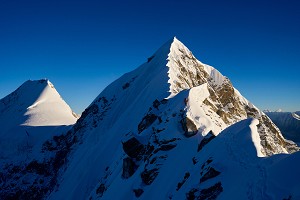
Wil Treasure and Duncan Barrack share a trip report from Greenland's Tasermiut Fjord, where they established 'The Bad Man from Bodie' E2 5b (650m) on the North Face of Half Dome this July. New routing on Greenland's granite walls is a dream for many climbers, but who'd have thought heat, mosquitoes and bolt clipping would be the biggest issues? This is a story about suffering, sage advice and striking gold...
"I'm not being funny, but I haven't seen any of your names in Alpinist recently," Tony had told me before we left. His words ran round my head as we struggled through the undergrowth. "It makes the Himalaya look tame."
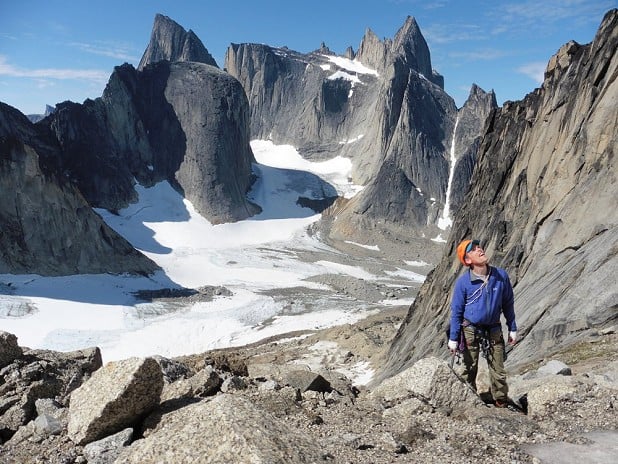
We'd left basecamp at 7am. Two and a half hours later we were tripping along the boulders in the valley floor, falling into gaps, getting swallowed by the dwarf birch trees and cursing the mosquitos in the heat. We were less than two miles from where we'd started.
"The lads were fitter, they beat a path through the trees, but that first year we were lucky, the helicopter dropped us off above the worst of it. I don't think we'd have done any climbing otherwise!" Tony had laughed. Sarah was deep in concentration on the armchair on the other side of their living room, sifting through a folder of topos and photographs. A mass of aged invoices, photocopied diagrams and handwritten notes spread out across the faded sofa and carpet. Despite its dated style the carpet was in remarkably good condition.
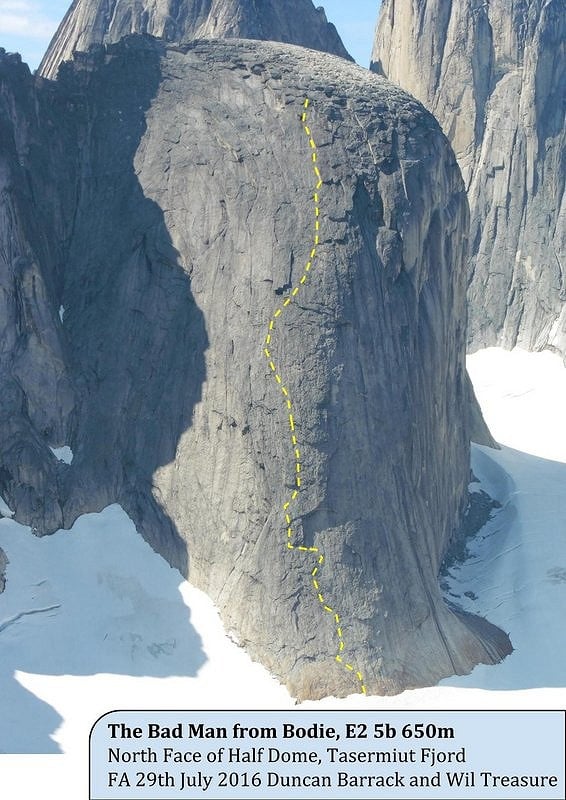
I'd dreamed for a decade of a chance to visit Tasermiut Fjord in Greenland. Those dreams were finally being realised, but I was starting to doubt how prepared I was. Tony was still talking, but I was rapt in the mess of information being fed to me. "I don't consider myself a local until I've done at least a thousand routes in an area..." I spotted a diagram which interested me and took a photo on my phone. "I carried on, no idea how much rope I had out..." I compared topos for two routes, trying to figure out if they could really be on the same face. Were they the same peaks I'd seen in a magazine all those years ago? "Sarah had to start climbing," Tony continued, "but there hadn't been a runner on the pitch, and of course there was no bloody anchor!" My attention piqued. "That was the nearest we've come to death on a climbing trip." Sarah must have turned her hearing aid back on, because she interrupted her husband at this point. "The nearest we've come to death *in North America*," she corrected him.
Tony rummaged in a bag, pulling out numbered reels of slides from their trips. He studied them carefully through gnarled fingers. Despite his inspection, none were rejected. A blurred image would appear on the screen: Chile, Joshua Tree, Yosemite. Every photo had a story. "Of course, you know who that is," he'd say. "Oh, it's a beautiful spot that. We never did manage to climb *all* the 5.11s." I'd finished my tea.
Eventually a slide focussed onto the wonky screen with an unmistakable profile on the hillside. Tasermiut. "The slides aren't dirty," Tony said, "that's the mosquitoes." He shot me a look, before grinning and clicking through to the next slide. Sarah wearing a headnet, completely swarmed by insects. "You might notice that there aren't many photos of good weather days," he said. "Too busy climbing for photography?" I asked, hopefully. He just laughed, but cast his eyes to the side. "That year the weather was pretty bad," he continued. "But 2008 was good." The slides moved on into photos of the Tininnertuup spires. Thousand metre granite faces at the northern end of the fjord. Tony and Sarah had completed several new routes there, along with a successful British expedition in 2008.
"How much fixed rope are you taking?" Tony asked. I was embarrassed to answer - we weren't taking any static. Dunc and I planned to climb alpine style on the peaks, sleeping on ledges and avoiding aid climbing as much as possible. "Most teams fix a few hundred metres," he said, "You wouldn't get up a new route otherwise." Our tactics weren't just a product of vanity, there were practical considerations - despite wanting to climb big walls in Greenland since I was a teenager, I've never actually done any big walls for training. I've never done any serious aid climbing. I've never spent more than a day on a route, save for the odd bivvy at the base of a wall. Dunc fared slightly better, with a couple of walls in Yosemite under his belt and a sworn desire to never aid climb again. We knew that at least the 2008 expedition had succeeded in climbing ground up and onsight on new routes in alpine style. We weren't under any illusions that we were anything like as good as that team, but surely we'd find things we could climb in a single push?
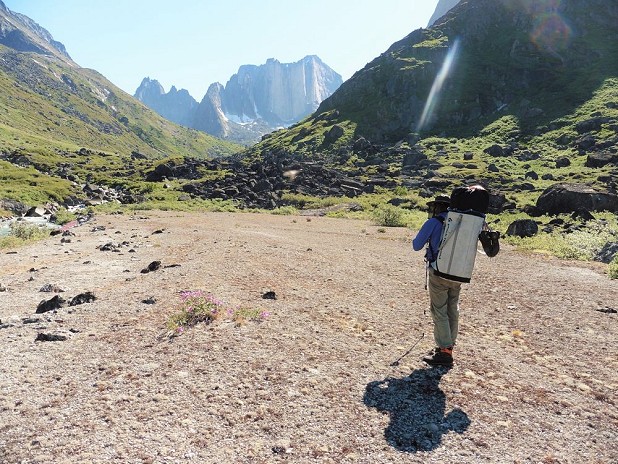
Back in the valley we gained height, but not enough to escape the mozzies. We abandoned boulder hopping along the hillside for what looked like better ground near the river. After a brief respite on the pebble beaches by the water we were back in the dense undergrowth. Hours went by and slowly the trees thinned as we climbed. Eventually we emerged onto steep scrub slopes with glacier melt cascading down the bare rock to our left. The 1400m south face of Ketil loomed out of the back of the hanging valley to the north, but the peaks above the glacier to the east were temporarily hidden. We hadn't gained a lot of elevation from base camp at this point, despite five hours of walking. A further three hours saw us up the slopes and moraine and finally out of reach of the mosquitoes. Nalumasortoq glowed in the afternoon light as shadows moved like sundials around the glacier. Exhausted, we found a spot to pitch the tent and eat and finally take our headnets off. We were both deflated. Everything about this place was hard. We rested and planned our tactics for the following day. Non Ce Due Senza Tre, a French-Italian route on the rightmost tower of Nalumasortoq. 850m of climbing over 19 pitches. We had hoped to climb the first half dozen pitches today and leave some gear, but that wasn't an option now.
We set off at 4am the next day with a large pack. We were hoping to climb the first 17 pitches and sleep on a ledge near the summit, then finishing the climb in the morning before abseiling off. It was 6am before we really started climbing. A beautiful HVS hand crack, a full rope length, followed by another pitch of easy slabs leading to a bolted belay. I clipped into the bolts, disappointed to find that there was nothing easy to back them up with. After taking in the slack I began to haul the bag as Dunc climbed. The rope came tight on the haul bag and it moved up slowly. I was fighting the friction on the slab and the bag seemed determined to catch on even the slightest protrusion. It came stuck again and I added a pulley to the system to get a little more purchase. BANG! I dropped and the rope swung. It took me a few seconds to realise what had happened. One of the two bolts in the belay had pulled straight out of the rock and we hung from a single 20 year old 8mm bolt. I screamed at Duncan to make himself safe, but I don't think he could hear me.
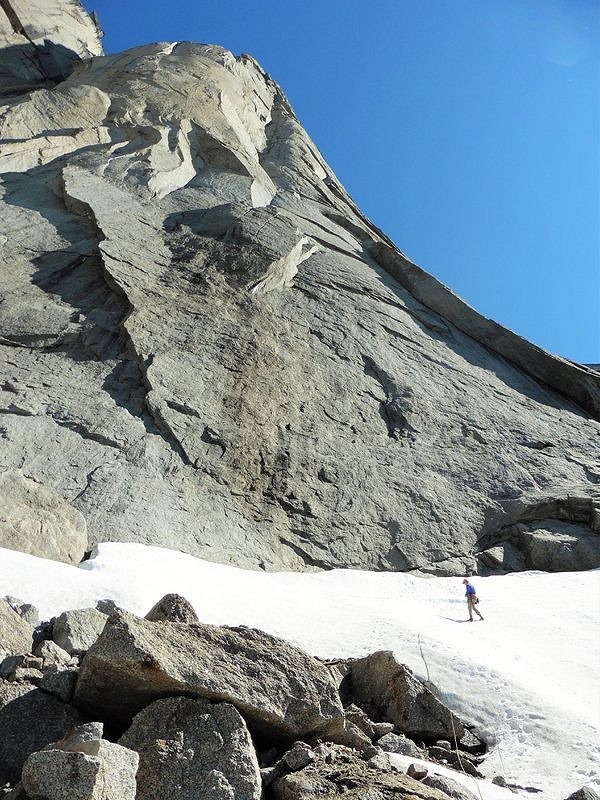
Back in Sheffield, when I'd finally extracted myself from Tony's stories and Sarah's measured advice, Tony had looked at me more sternly and had one more thing to add. "Come back safe and come back friends." I thought of this as I looked up the face, two pitches on from our blown belay. Above, the face steepened and a bolt glinted with a mane of faded tat hanging from it above a blank wall. It looked to be at least eight metres up the face, with no apparent gear before it and no obvious features to climb. We'd already admitted defeat at this point, the wall appeared to offer no prospect of ledges to sleep on until near the top, meaning that speed was going to be important and we were already behind schedule on the easy part. We abandoned our haul bag and decided to climb as far up the face as we could before bailing. From this end of the valley, out of sight of the rest of the team at basecamp, I felt isolated.
The direct line looked too necky, but we found a way 15m to the right to climb in using a series of narrow ledges. Big runouts and loose holds, but mostly positive and steady climbing. I made it to the belay, comprised of an 8mm bolt and two old rivets, luckily with a nut placement beside them. Duncan followed before setting off up the next pitch, clipping the bolt as his first runner, before promptly departing company with the rock along with his handhold. Pulling back on he traversed rightwards towards a shallow depression, slightly out of my sight. The odd curse was carried by the gentle breeze and I could make out a hand reaching to the back of his harness, then again, replacing kit. Nothing seemed to fit.
After some time he made it to a point where I could see him again, and the line became more obvious, up a large layback flake in an intimidating position. "Where do I go from here?" he shouted, "I can't see the belay!" He still had another 25m of climbing to do up the flake, but up close its size became apparent, with large cams needed to protect it. Duncan paused for a moment before messing with his gear once more. I thought he was going to commit to it, but he shouted down to lower him off. Back at the cramped belay he apologised, but said it was too loose. I was glad, the whole affair was beginning to look misguided. We bailed. The next day we walked back to a basecamp, bumping into some of the rest of our team near the river. The walkers had been successful, but the climbers had been defeated.
Our first taste had been bitter and we wondered whether our tactics were too optimistic, but the forecast remained perfect. The following day, three of the team managed a ten pitch E1 on Ketil Pyramid. Dunc and I repeated it a few days later and climbed another slightly harder line to the right as well; we were getting somewhere. From the summit we had a wild panorama into the next valley. Ketil's West Face presents a sweeping 1400m slab of perfect granite, with not a ledge to be seen and an obvious overhang barrier several hundred metres up. To the south the pillar of Ulamertorsuaq caught the sun, with the 400m upper corner on the face in shadow, along with the intimidating and unclimbed north face. Seracs hung over the glacier on its north side, waiting for a sneeze to send them on their way. Nalumasortoq clipped the beams of evening light rising up the face from the glacier.
Having discovered the trail on the other side of the river, we formed a plan to repeat an Italian route, Les Temps Sont Durs, on a peak called Half Dome, a north-facing 600m wall near our previous attempt. We knew nothing about it except for a hand drawn topo an Argentinian team had given us, but it was technically easier and shorter than our previous objective. However, inspecting the route in the evening through binoculars we weren't encouraged. We couldn't see any of the belays that we'd hoped were in situ and the features the route followed seemed vague. We got up early the next morning to get on the route, but ended up back in our sleeping bags after breakfast due to the cold. We thought we'd get on the face once it was in the sun a little later, since it was light until 11pm. When the alarm went off we ignored it and went back to sleep, then spent a pleasant day lazing in the warm sun on the glacier. We were more tired than we realised.
After considering our options we decided the most sensible thing to do was to climb a new route on the face. At least that way we couldn't get off route. We'd scoped out a line through the binoculars which led from a flake at the base of the face, some 50m left of Les Temps Sont Durs, up the faint, blunt rib which marked the point where the angle lessened slightly. We could see that there were cracklines up at least part of the face, and it looked possible to skirt around the overhangs.
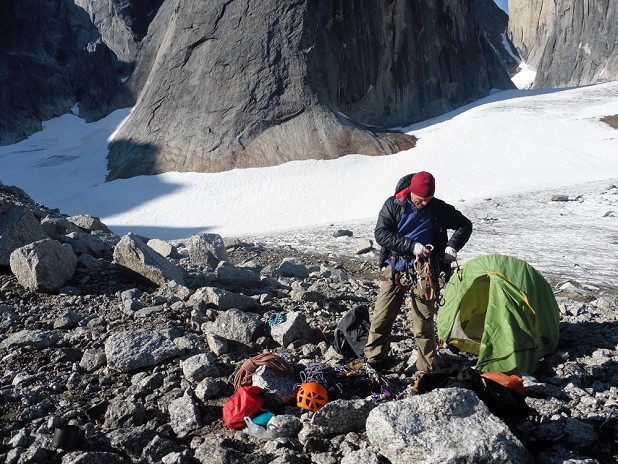
We set off as the sun hit the face the following morning. The first pitch climbed beautifully solid golden rock, leading to vague depressions and flakes, with some sizeable runouts up positive climbing. Higher up, the face steepened slightly and the flakes became less solid. Gear placements were hard won in a few places, but the climbing was never desperate. We swung leads in long pitches, with technical sections alternating with bold ones in just the right mix to play to our strengths. Ledges were rare but the belays were solid and comfortable. High on the face, as it curved back towards the summit, there was a frightening pitch on giant overlapping flakes. Thankfully the section was short lived and the rock became more solid. It had grown late, but we hadn't spoken about it. At each belay I took the rack from Duncan and set off before he could object. He did the same. After a while it became apparent that we weren't backing down from this. We came to a series of corners near the top of the face, convinced that we'd be on top in half an hour, but each corner led to another, and another. Full rope length pitches rising up the slabs until eventually a bolt shone on a sloping ledge to our left. We had inadvertently crossed over the finishing pitches of the Italian route, joining it for the final scramble to the summit. It was 10pm.
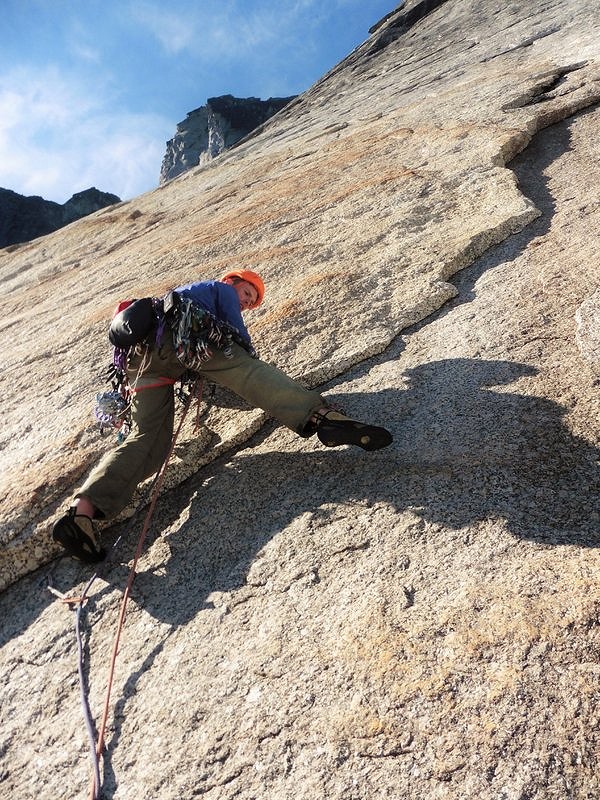
The scramble led to a hollow behind a boulder. We both felt physically fresh, but mentally tired. With the prospect of abseiling into a dark void on an unknown route, we decided to hole up behind the boulder for the night and shiver it out. We ate the last of our Jelly Babies and saved two squares of chocolate each for breakfast, before radioing basecamp and curling up on our rope bed. The sun slid beyond the horizon, behind neverending nameless peaks, descending into a deepening orange glow which hovered across the mountaintops through the short night, fading into purples and blues and the brighter stars. I shivered on the ledge and Duncan shivered beside me. Sleep was fitful, sometimes waking with a shiver, only to open my eyes to the near darkness. As the morning light strengthened, the peaks to the east showed even more unlikely looking seracs. Rivers flowed out the of the base of the ice fields on the faces. We set off down our face once the sun returned, trying to follow the paper topo and link the old bolted anchors on the Italian route, replacing each piece of tat as we went and taking the old ones as souvenirs.

Seven hours later we were back at the base, dragging our tent out of the rock gap it had blown into and gorging ourselves on cheese and tortillas. It soaked in slowly that my teenage dream had been realised - we'd climbed a new route in Greenland. Tony had told me before I left that the mosquitos weren't the only bug to watch out for in Tasermiut. That it would be hard not to return. I knew what he meant.
Wil and Duncan would like to add a thank you to a few people who helped them out with this trip, specifically: the rest of their team, Tony and Sarah Whitehouse, Rab and Marmot, and The Quay and Dart Rock climbing centres.

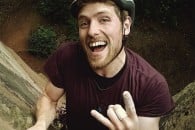

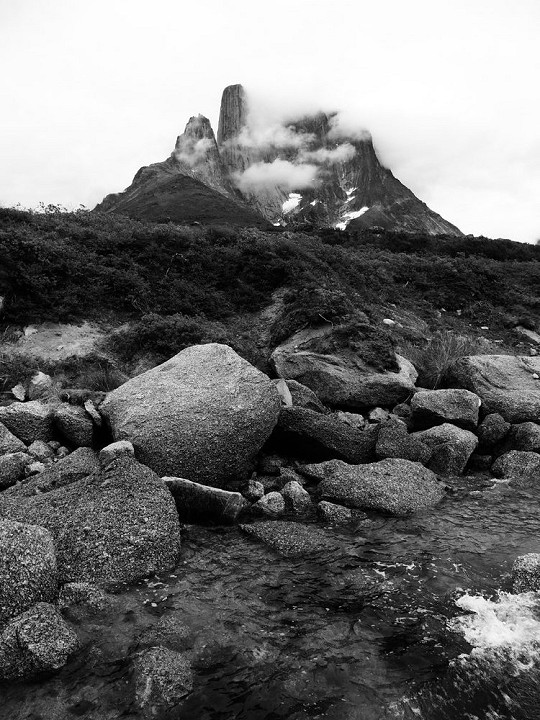
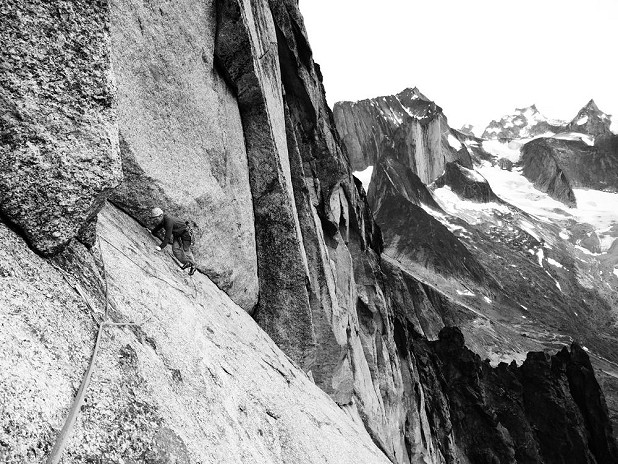
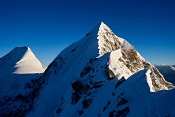
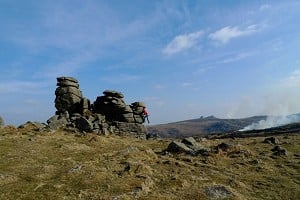
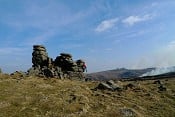
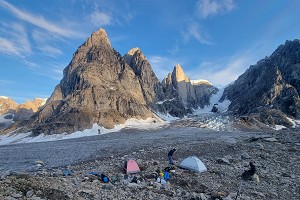
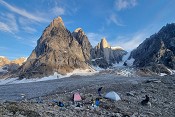








Comments